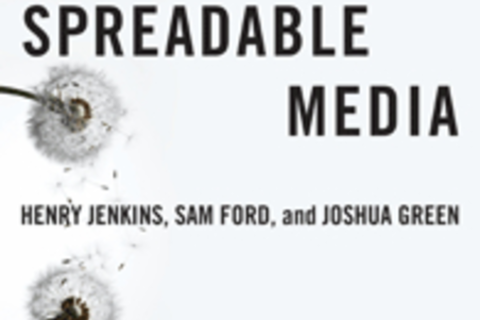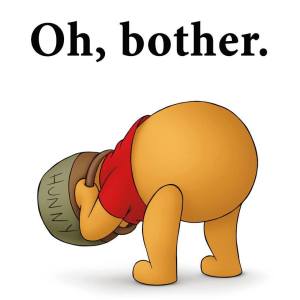Key Terms and Concepts
Spreadability: A property of content describing its ability to shared among and through networks; the higher the spreadability, the easier it is to share the content to other people and through gatekeepers like digital rights management and economic and technological barriers.
Media: Content that is encoded in a topological, lexicographical, or iconographical manner.
Summary
Spread or Die
It’s starts right on the very first page: “if it doesn’t spread, it’s dead” (1). Positioning Spreadable Media as a look at media from both the bottom-up and top-down, Jenkins, Ford, and Green, quickly get to the point. Digital culture is composed of people who are “shaping, sharing, reframing, and remixing media in ways which might not have been previously imagined” (2). They are transforming the works they interact with in ways both profound and mundane. To exist in this new ecology, though, to move between the actors and boost along the network, media needs to be spreadable.
What does it mean for media to be ‘spreadable’?
Spreadability is “the potential — both technical and cultural — for an audience to share content for their own purposes, sometimes with the permission of the rights holders, sometimes against their wishes” (3). In one case, it might mean uploading a television episode to YouTube, or could mean fans subbing anime not available in certain markets. It each instance, though, the media survives longer and proliferates more because it has this same quality: it is spreadable.
However, this spreadability is limited by a number of factors. The first of which is the technical resources needed to circulate the media. The more restrictions placed on the media in terms of digital rights management or just simple legalities, the harder it is to spread around to other actors. If it is locked away, or even takes more experts to handle, the less likely it will spread. The more control over it, by means of market, law, access, or anything else, really, the greater the investment needed to move it and the decreasing case it will be spread.
The second (and arguably the most important) factor is the economic structures around, containing, and within the media itself. How much does it cost in work to move the media? How many people are needed to create it? Maintain it? How about transfer its content between mediums? How much, in other words, does maintaining and spreading the media cost? If it is too great, it might not last.
The same can be written for the last two factors: the attributes of the content itself, and social networks through which it is shared and given value. Like other resources, if the media has great worth to the members of the network it will spread throughout their interactions. If, however, the attributes of the content prevent it from spreading somehow, if is has some inherit fragility, for example, its spread will be slow and careful, with each new link measured for security and stability. It will still spread if it has great worth, of course, but much slower and with greater deliberation.
Stickiness is not spreadability.
Jenkins, Ford, and Green mark a clear difference between stickiness and spreadability. Stickiness, they write, “capitalizes on the easiest way companies have found to conduct business online — rather than the ways audiences want to and do experience material online” (4). These companies creates sites and drive people to them. However, they also do more, borderline nefarious, things as well. They create, in the words of Jenkins, Ford and Green, “virtual ‘roach motel[s]” where media gets collected and ultimately “dies” instead of moving along to new places (6). Instead of spreading media around, they explain, the stickiness is trapping users and preventing them from using media or changing it to suit their needs.
The term stickiness originally comes from Malcolm Gladwell, they write, but has been put into use in all matter of marketing campaigns. What started as a way to get people to come visit a site and spend some time has morphed into targeted strategies to keep users trapped there indefinitely. In some cases, this has even meant opening new windows or finding ways to disable the ‘Back’ button in a user’s navigation history. Anything, in some extreme cases, for keeping a user around as long as possible and with zero hope of them finding things to them share outward along social networks.
Sharing is caring!
The decisions around whether to share something are grounded in its context: “Is the content worth engaging with? Is it worth sharing with others? Might it be of interest to specific people?” (13). To see media shared between people is to assume a relationship of some kind; however, people often don’t think of the content itself (or what might be behind it), but of the messages imparted with the content. Users want “to feel like they’re a part” of the discourse around some content, to be in on the joke or meme shared (14). It is this sharing, and the media embedded within the networks of worth, that guide the spreading.
The users here are not infection vectors only, though, as Jenkins, Ford, and Green point out. Users are not getting content to go “viral,” nor are they trying to infect their friends with some material. No, “audiences play an active role in ‘spreading’ content rather than serving as passive carriers of viral media; their choices, investments, agendas, and actions determine what gets valued” (21). “Spreadability,” they write, “assumes a world where mass content is continually repositioned as it enters different niche communities” (27). Users are bringing content back to others because they see worth in it, not because it has changed them into zombies capable of only infecting others; it is much more about the users, their intentions, and their actions than the content itself.
Web 2.0: Fail?
The promises of Web 2.0 were not delivered, state Jenkins, Ford, and Green. The “ideas behind Web 2.0 have led to a proliferation of start-ups looking to monetize and commodify user-generated content” (47). The freedom that was promised in the wake of greater interactivity with online content and the growth of social network has also opened the flood gates of companies licensing and constricting the use of the content users generate. There has been a breakdown in the differences between the social and moral understanding of what is “labor,” “work,” and “free” among the creators and commercial operators. Explain Jenkins, Ford, and Green:
There is a considerable gap between the Web 2.0 rhetoric of happy collaboration and users’ actual experiences working with companies. On the one hand, the mechanisms of Web 2.0 provide the preconditions for spreadable media; many of the key tools and platforms through which material is spread operate according to Web 2.0 principles. On the other hand, conflicting expectations of what constitutes fair participation means that the actual spreading of media content remains a contested practice. Pg. 49
The application of the DMCA to YouTube videos, for instance, is a frequent point of contention between creators and the tools in place to flag and hopefully remove copyrighted material. Through the use of automated processes to target videos containing copyrighted songs and video content, creators have had to defend what might be “fair use” through contesting systems that often assume a guilty-first stance. Jenkins, Ford, and Green echo other critics who characterize such actions as having a “chilling effect” on the future of creating content (50).
Object(ive) Worth
Each group places different value on content. Where one group might see a moral worth on some content, others might only consider it from a commercial setting. Each, though, must navigate been the two as artifacts pass between them. Specific to the commercial sense, Jenkins, Ford, and Green explain that “there is a tendency to describe appraisal, at least as performed within a commercial context, as a highly rationalized process designed to determine an object’s absolute value. Yet appraisal is also a negotiation between different systems of evaluation, determining not only the object’s value but also how that value can be measured” (83). Using the examples of Antique Roadshow and eBay, Jenkins, Ford, and Green discuss how each have a different version of how worth is applied after something is appraised.
The one, Antique Roadshow, presents the appearance of experts discovering a hidden value, a production designed around supporting the dream of having treasures in an attic or passed down through family members. The other, eBay, have people often thought of as “amateur” in their appraisal, yet undergo the same performance. Both have a community around trying to find the best “worth” while also speculating about how a buyer (eBay) or ‘expert’ (Antique Roadshow) might assign some value.
This form of speculation about worth is contrasted with the ‘gift’ economy found on many social networks. Through sharing content or posting towards one single person, a ‘gift’ is sent without often expecting the same in return. It’s what Jenkins, Ford, and Green describe as “transactions depend[ing] on sociality but not necessarily reciprocity” (90). The ‘gift’ economies support the underlining network of relationship, not necessarily in evaluating how much each content share might be worth; often, even, the value placed on the ‘gift’ is nominal outside of the sharing and support of actors in the network. Its ‘worth’ is in the sharing, not its assigned value in any other group.
How do people participate?
People lurk first. Drawing from Jean Lave and Etiene Wenger, Jenkins, Ford, and Green, make the connection between new users within a community and those watching it from the sidelines to learn the rhetorical and social rules. It is through this activity, write Lave and Wenger, that “legitimate peripheral participation” happens and new comers are are able to first observe (lurk) and then move toward more active participants (158). They must first see what happens from the outside before they can be made part of the community.
Once inside, we “participate in something, that is, participation is organized in and through social collectives and connectivities” (163). In quoting Daniel Dayan, Jenkins, Ford, and Green, record: “A public is not simply a spectacular in plural, a sum of spectators, an addition. It is a coherent entity whose nature if collective; an ensemble characterized by shared sociability, shared identity and some sense of that identity” (2005, 46). We act within a social sphere through a performance that reenforces our social links and echoes our consensus beliefs. By becoming part of a community, we agree with their overlapping ideologies and act, to some degree, as part of that collective in the process.
Curation, Conversation, and Circulation
To maintain these links, we act through three ‘C’s: curation, conversation, and circulation (171). We maintain collections of content as part of our community interactions. Be it part of utterances as embedded through a specific image shared or video played, we build a communal set of iconography that represents the thoughts of the community at the moment. And we talk about this content, creating or reenforcing social bonds through our conversation and discourse. By participating in a community, we become part of its information workflow: we maintain its imagery, embed its ideas, and circulate its feeds.
Jenkins, Ford, and Green place the community of users and their actions above their commercial value. Instead of being merely selling points, they see “that audience members are more than data, that their collective discussions and deliberations — and their active involvement in appraising and circulating content — are generative” (179). People, and their participation, are at the heart of the how spreadable media works: without the people, there are no social networks and no fertile soil for media content to thrive.
It is this empowering that raises participation into the fundamental source of understanding spreadable media. Write Jenkins, Ford, and Green, “In a world where everyday citizens may help select and circulate media content, playing active roles in building links between dispersed communities, there are new ways of working around the entrenched interests of traditional gatekeepers and in allegiance with others who may spread their content” (288). Instead of being based on the content or the ways it may be repressed, Spreadable Media holds an emphasis on the people and their actions — media is only spread through them!
Connections to Lingua Fracta, New Media
Jenkins, Ford, and Green don’t define media. Instead, they spend most of the book on trying to describe relationships around and through using media on primarily digital networks. The users, their intentions, and the outcomes of sharing media are of a far greater concern than trying to pin down what might be media, content, or the differences between the two in a digital sense.
However, while there isn’t an emphasis on the second word of the title, the first word, spreadability, holds a strong sense of collision with terms important to New Media and Lingua Fracta: archives, interface, and perspective. Grounding their analysis in what users do, how they view it, and what ‘worth’ it might have for others, each term resonates with how Jenkins, Ford, and Green see the importance of media and its spreadability in maintaining the longevity of the media itself across networks.
While not addressing archives directly, Jenkins, Ford, and Green do spend time on how media might survive through time and across contact with different groups. Mentioning projects like communities subbing anime that might not be available in some markets and fans uploading older television episode to YouTube, Jenkins, Ford, and Green circle around some archive worries by looking into the intentions of the users in their actions to expand the reach of content, not necessarily how that content might survive by itself (it won’t).
They also spend some time on how financial and technological barriers prevent media from spreading outside of some communities. By lacking the right hardware, software, or access to protocols, the interface, both in a literal lack of connection to larger networks, and metaphorically, though not being able to produce the same file formats or use certain frameworks, prevents some communities from having much contact with others. The spread of media between them, then, is incredibly sparse, if existing at all.
The same, in a way, can be written about perspective, too. The emphasis Jenkins, Ford, and Green place on the narratives of moving across content tracks with Rice in Lingua Fracta. Jenkins, Ford, and Green see the stories users tell about objects (through communities like eBay) as more important than any “official” messages. Looking to create ‘gift’ ecologies through maintaining relationships with sharing content, users will often diverge tremendously from those narratives crafted by commercial means. Through fan stories and slash fiction, the narratives created and remixed from the same source material gain a greater importance to the community, often supplanting those shared by commercial producers.




Jenkins, Ford, and Green propose an idea that would explain why illegal music downloads are actually beneficial to the industry, particularly for new bands; also how efforts on the part of record labels to limit consumer ability to do so could hurt the spreadability and, potentially, the industry. In fact,the whole topic of spreadability seems difficult to separate from the issue of intellectual property. On one hand, the thought of indiscriminate sharing and/or remixing of artistic works may seem undesirable to their creators; on the other hand, as you note “the media survives longer and proliferates more” ultimately.
I like also here the emphasis of power residing with people. It seems to me that much of what we’ve read this semester has made me feel like the public is seen as lemmings absorbing whatever Big Media feeds us. Here, the authors acknowledge that “Users are bringing content back to others because they see worth in it, not because it has changed them into zombies capable of only infecting others.” This statement shifts the power from an all-controlling media to a discriminating, thinking public in charge of what constitutes relevant media in the first place.
Good overview of the work!
Jenkins, Ford, and Green address the necessity for spreadability as a way to build community interactions. You bring up a significant barrier, though, when you point out that “financial and technological barriers prevent media from spreading outside of some communities. By lacking the right hardware, software, or access to protocols, the interface, both in a literal lack of connection to larger networks, and metaphorically, though not being able to produce the same file formats or use certain frameworks, prevents some communities from having much contact with others.” I have the issue of spreadability in mind when curating my multimedia project because I want the resources I create/gather to be easily accessible to site visitors. I hope to address this by making the format visually-simple to make it mobile-device friendly. I will create brief video tutorials on my own, but most of my links and handouts are made available through Creative Commons licensing. This way, I hope to limit financial barriers between students and writing tutorials. How is your project spreadable?